What if your feedback tool was doing everything right — but still not quite enough? That’s the point many teams reach with 15Five. It’s a strong performer, no doubt, but as your organization grows, you start craving more flexibility, deeper insights, and a system that fits your exact workflow. That’s when exploring 15Five alternatives starts to make sense.
Over the years, I’ve seen companies of all sizes rethink how they handle performance reviews, 360 feedback, and engagement tracking. The truth is, there’s no one-size-fits-all platform. Some teams need richer analytics, others want tighter integrations, and many just want something simpler and faster to roll out.
In this guide, I’ve rounded up 12 of the best 15Five alternatives that meet those evolving needs — tools that help you connect feedback, performance, and growth into one seamless experience.
Why Consider Alternatives to 15Five?
15Five has a lot going for it: a user-friendly interface and effective features for check-ins, OKRs, and engagement. However, companies often start looking for 15Five competitors when they need something slightly different.
Maybe you want more customization or a specific feature like advanced analytics, deeper integrations with your HRIS, or a more budget-friendly plan. Perhaps your team found 15Five’s interface unintuitive in some areas, or you need a tool that excels at one specific capability (like anonymous feedback or in-depth learning modules). The good news is that the market is full of innovative performance management platforms.
In fact, the landscape has exploded with new players offering continuous feedback, engagement surveys, goal tracking, and AI-driven insights beyond what 15Five provides. By exploring alternatives, you can find a solution that matches your company’s culture, size, and objectives.
List of Top 12 15Five Alternatives
Before we get into detailed reviews, here’s a quick overview of the 12 best alternatives to 15Five. This table highlights each tool’s primary focus (“Best for”) and pricing at a glance:
| Tool | Best For | Pricing |
|---|---|---|
| PeopleGoal | Boosting Employee Performance & Improving Engagement | FREE 7-day trial. Paid starts at $4/user/month |
| Lattice | Large enterprises with integrated HRIS needs | Starts at $10/user/month |
| Betterworks | Continuous performance & goal management | Custom pricing |
| Culture Amp | Cultivating company culture through engagement | Custom pricing (approx. $5–$6/user/month) |
| Leapsome | Performance management & learning | Custom pricing |
| BambooHR | Comprehensive HRIS With Payroll Solutions | Custom pricing. |
| Engagedly | AI-powered performance, engagement & learning | Starts at $5/user/month (annual) |
| PerformYard | Flexible performance review cycles | Starts at $5/user/month |
| HiBob | All-in-one HRIS for HR & basic performance | Custom pricing |
| Officevibe | Employee engagement feedback and insights | Starts at $5/user/month (annual) |
| Quantum Workplace | Data-driven engagement & performance analytics | Starts at ~$5/user/month (bundle pricing) |
| Reflektive | Continuous feedback and recognition focus | Starts at $6/user/month (Performance module) |
1. PeopleGoal – Best for Boosting Employee Performance & Improving Engagement
When I implemented PeopleGoal for our team, I was impressed by how it brought structure and motivation together. I used it to streamline our performance reviews and goal tracking, and it had customizable workflows and templates that made tracking performance metrics straightforward.
The continuous feedback system fostered a culture of improvement – employees actually wanted to grow because feedback was constant and constructive. I particularly enjoyed the engagement features: we set up peer recognition programs and sent out pulse surveys, which really boosted team morale.
Honestly, PeopleGoal felt like more than a measurement tool; it actively helped enhance our performance and engagement.
Pros:
- Offers a fully customizable interface that lets you tailor workflows, goals, and feedback processes to match your organization’s unique structure.
- Supports OKRs, SMART goals, and weekly tasks to keep everyone aligned toward company objectives.
- Dedicated App Store workflows to add HR processes like onboarding or surveys without coding.
- Enables regular check-ins, one-on-one meetings, and continuous feedback, so managers can coach and employees can improve continuously.
Cons:
- No downloadable or on-premise version
- Dark user interface option is not available
How PeopleGoal Compares to 15Five:
15Five is great for quick check-ins and continuous feedback, but PeopleGoal gives you more room to customize how performance management works for your team. It lets you build custom review workflows, goal templates, and feedback forms that fit your exact process—something 15Five doesn’t offer. PeopleGoal also includes OKR tracking, engagement surveys, and peer recognition, all within a single, easy-to-use platform. While 15Five focuses mainly on engagement and weekly updates, PeopleGoal delivers more flexibility, deeper insights, and scalable workflows.
Pricing:
FREE 7-day trial. Paid starts at $4/user/month.
2. Lattice – Best for Large Enterprises With Integrated HRIS Needs

Image source: Lattice
Lattice is widely adopted by HR teams looking for a central command center for people management. It unites reviews, feedback, goals, and engagement surveys into one platform that scales well for growing teams. The interface is clean and designed for structured performance cycles that integrate seamlessly with existing HR systems.
Managers can automate multi-step workflows, align individual goals with top-level objectives, and analyze performance trends through powerful dashboards. Lattice’s OKR tracking and public recognition tools also help promote accountability and appreciation across teams.
Enterprises particularly value Lattice for its analytics depth. The ability to visualize engagement scores, completion rates, and goal progress in one place makes it ideal for organizations that want a data-driven approach to performance and development.
Pros:
- An all-in-one platform covering performance reviews, continuous feedback, and employee engagement surveys together.
- Managers can easily schedule and log one-on-one meetings directly in Lattice, keeping those conversations documented.
- An effective analytics dashboard provides real-time insights and visualizations of performance and engagement data.
- Built-in tools for peer recognition and public praise help strengthen a culture of appreciation.
Cons:
- The barrage of Lattice notifications can become overwhelming in large teams
- The entry-level plan is somewhat limited; many useful features (like OKRs or advanced analytics) require upgrading to higher-tier plans
How Lattice Compares to 15Five:
While 15Five excels at quick check-ins, weekly reflections and keeping feedback flowing, Lattice leans toward a more structured, data-driven performance system suitable for growing teams. Lattice offers robust goal tracking (OKRs), customizable review cycles, rich analytics and built-in HR tools, making it ideal when you’re looking to scale feedback into strategic talent-development—not just engagement.
Pricing:
Starts at $10/seat/month (billed annually).
3. Betterworks – Best for Continuous Performance & Goal Management
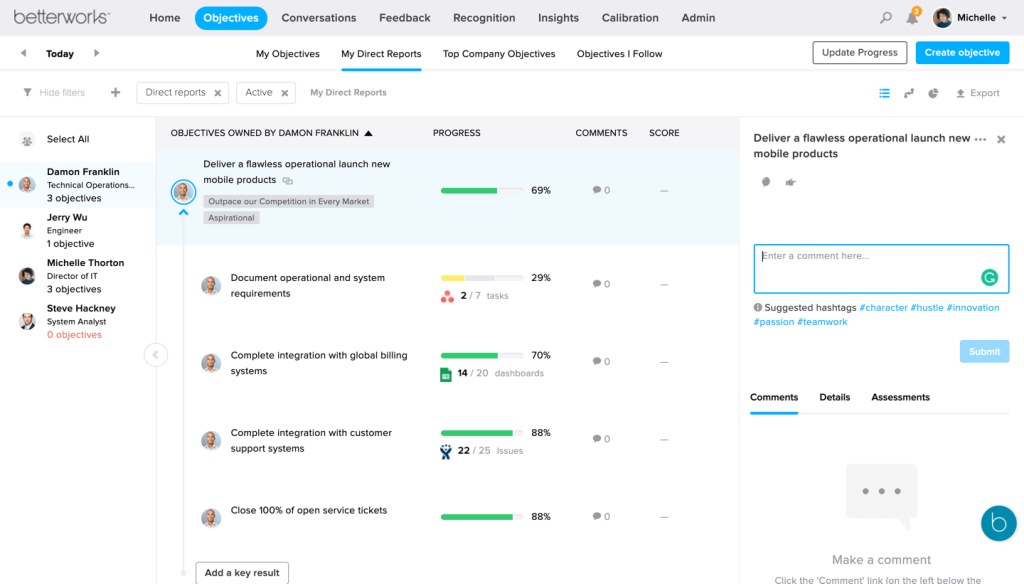
Image source: Betterworks
We adopted Betterworks to strengthen continuous performance management and goal alignment across our company. In hindsight, Betterworks offered a rich set of tools for performance reviews, feedback, surveys, and OKRs that really helped drive employee development.
Managers liked the data-driven approach: the platform’s analytics and insights encouraged us to have more fact-based performance conversations. I appreciated how configurable the goal-setting was – we could set company-wide objectives and cascade them to team and individual OKRs, then track progress in real time.
On the feedback side, employees could request feedback or give shout-outs, which fostered a nice culture of recognition. One limitation I encountered was that Betterworks doesn’t include learning or L&D content natively, meaning when we wanted to assign training materials, we had to integrate with LinkedIn Learning instead.
Pros:
- Comprehensive continuous performance toolkit includes structured reviews, goal/OKR management, one-on-one meeting tracking, feedback, and engagement survey templates.
- Highly configurable goal-setting and OKR features – we could customize goal cycles and align individual goals to larger objectives easily.
- Integrates with many systems (like HRIS platforms and learning apps) so you can extend its capabilities.
- Supports 20+ languages, which is a plus for global teams.
Cons:
- Lacks built-in learning and development modules – you’ll need separate tools or integrations if you want to deliver training or courses.
- A few UI quirks, like the goal filters, were not very intuitive to use at first though we adjusted over time.
How Betterworks Compares to 15Five:
While 15Five excels at weekly check-ins and feedback loops, Betterworks steps up the game by offering deep goal alignment, enterprise-grade OKRs, and advanced analytics. It’s built for organizations with complex structures – multiple departments, frequent cross-team collaboration, and rigorous performance cycles. For teams that want data-driven insights and a scalable performance management architecture, Betterworks delivers more strategic control than 15Five.
Pricing:
Custom pricing.
4. Culture Amp – Best for Cultivating Company Culture Through Engagement

Image source: SaasList
HR professionals often rely on Culture Amp to strengthen company culture and engagement. The platform excels in research-backed employee surveys that measure everything from satisfaction to manager effectiveness. Its user-friendly interface helps organizations collect data without overwhelming employees.
Culture Amp turns data into action. The system surfaces focus areas—like recognition or career growth—and guides managers with ready-made action plans and recommendations. It also supports DEIB analytics, helping companies ensure inclusivity in feedback.
While it includes performance review and goal-tracking capabilities, its true strength lies in engagement intelligence. Organizations that want to link people’s insights to business outcomes find Culture Amp especially effective for driving cultural improvement.
Pros:
- Excellent for measuring and improving engagement: it provides ready-to-use survey templates (based on research) and benchmarks, making it easy to get started.
- AI-powered insights highlight key takeaways from survey results (e.g., pinpointing what factors are most correlated with engagement at your company).
- Offers analytics on Diversity, Equity, Inclusion & Belonging (DEIB) – you can slice data to see how different groups experience the company.
- User-friendly interface that both HR and managers found intuitive.
Cons:
- Culture Amp has no built-in HRIS, so you will need to sync it with your HR system or upload employee data regularly.
- The platform is heavily cloud-based and online – not an issue for most, but worth noting that offline access is essentially non-existent.
How Culture Amp Compares to 15Five:
While 15Five focuses on frequent check-ins, performance reviews, and goal tracking, Culture Amp takes a wider lens—including deep employee-engagement surveys, sentiment analytics, and benchmarking. I found Culture Amp especially useful for uncovering hidden engagement trends and linking them to business outcomes, making it ideal for teams that want to turn feedback into strategic insight rather than just track performance.
Pricing:
Custom pricing.
5. Leapsome – Best for Performance Management & Learning
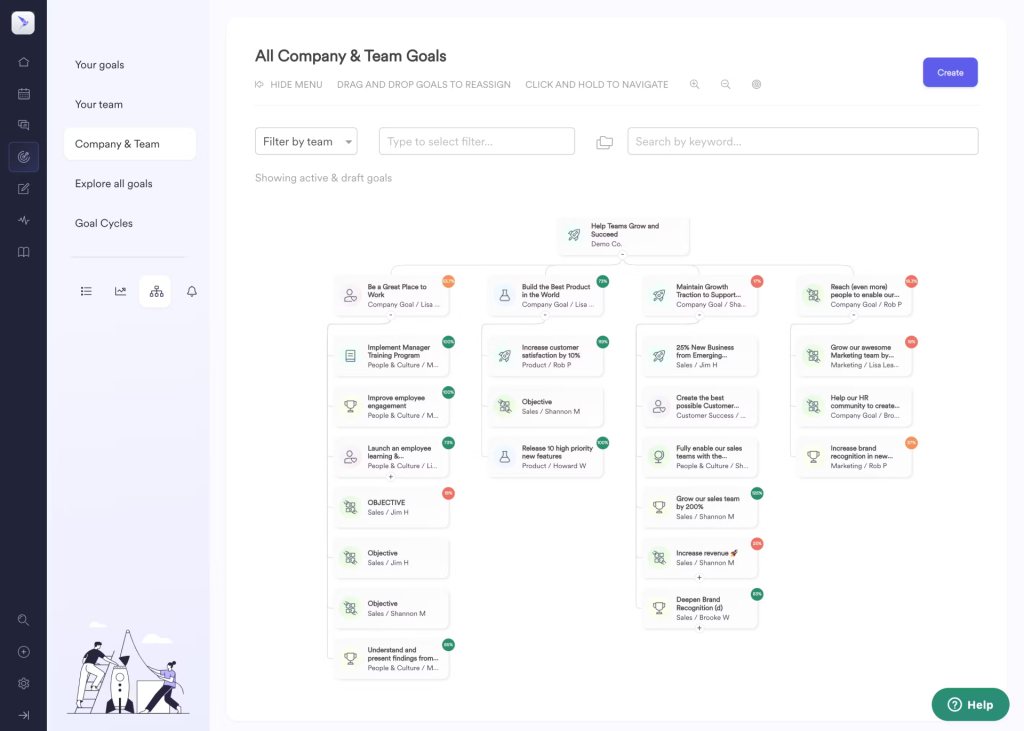
Image source: Leapsome
When I was searching for an all-in-one platform that could handle performance management and employee development, I gave Leapsome a try. I could conduct performance reviews, set goals and OKRs, gather 360° feedback, and even launch learning modules, all within the same system.
Leapsome can tailor personalized learning paths based on an employee’s goals and review feedback. For example, after a performance review, we could assign learning content to address development areas, directly through Leapsome.
I also appreciated the continuous feedback and coaching tools, which prompted managers to give regular feedback (sometimes with AI-generated suggestions). The analytics were gold: Leapsome’s dashboards helped identify trends like which competencies needed strengthening across the team.
Pros:
- Leapsome combines performance reviews, engagement/pulse surveys, goal/OKR tracking, and even learning & development tools in one place.
- Great continuous feedback and coaching features – employees and managers can exchange real-time feedback, and the system can prompt follow-ups or nudge you to give praise regularly.
- Supports customizable review workflows, which was useful because we could tailor performance review questions and cycles to different departments.
- Strong 360-degree feedback capabilities give a holistic view of performance by including peer, direct report, and manager feedback.
Cons:
- Leapsome is a cloud platform, and if you’re offline (e.g., no internet), you can’t use it.
- Leapsome’s new HRIS module (they introduced a core HR database recently) comes at an additional cost.
How Leapsome Compares to 15Five:
When I switched to Leapsome, I noticed instantly that it’s built not just for tracking performance, but for enabling growth. Unlike 15Five—where the focus is often on quick check-ins—Leapsome lets you run highly customizable review cycles, blended with learning paths and detailed analytics. If you’re looking for a platform that ties feedback, development and results into one experience, Leapsome offers more depth and structure than 15Five.
Pricing:
Custom pricing.
6. BambooHR – Best for Comprehensive HRIS With Payroll Solutions
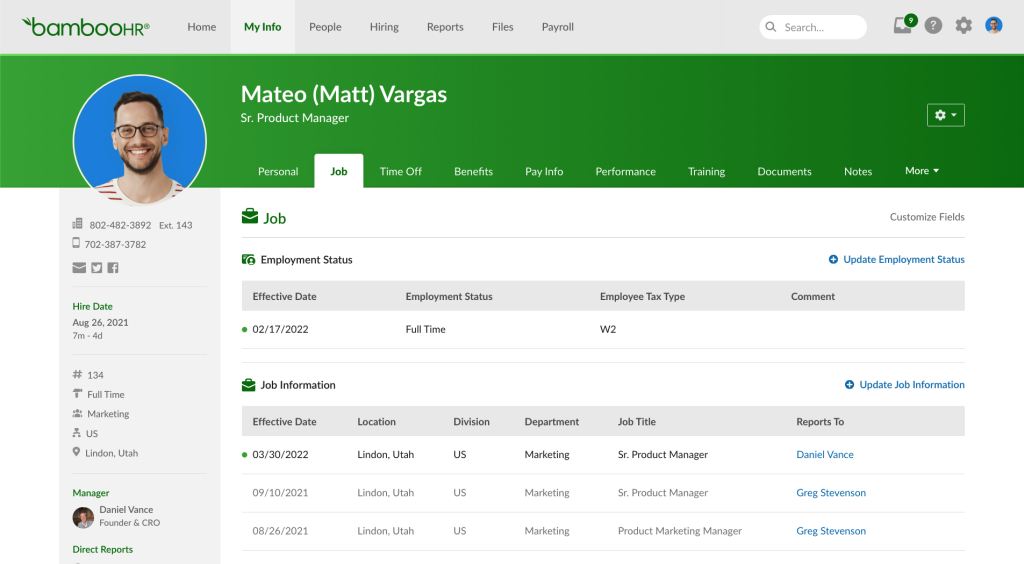
Image source: BambooHR
BambooHR serves as a complete HR suite that also handles performance reviews. HR teams appreciate how it unifies employee records, onboarding, time-off management, and payroll with basic goal-setting and review tools.
The performance management module enables managers to run self-assessments, gather feedback, and track goals alongside employee data. Employees can easily complete reviews since they already use the system for other HR functions.
For companies wanting one platform for HR and performance, BambooHR delivers convenience. While it lacks deeper analytics and continuous feedback capabilities, its simplicity and integration with payroll make it ideal for small to mid-sized businesses.
Pros:
- BambooHR consolidates HR data management, PTO tracking, recruiting, and performance management.
- Provides tools for setting and tracking goals, and generating detailed performance reports, which gives our managers good visibility into progress.
- Employee self-assessment and self-service features encourage employees to take an active role in the review process.
- Because it’s an HRIS, things like onboarding flows, role changes, or terminations are tied in with performance records and documents seamlessly.
Cons:
- While BambooHR covers the basics (goals, reviews, feedback forms), it lacks some advanced performance features like continuous feedback tracking, competency frameworks, and AI-driven insights for development planning.
- BambooHR’s mobile app is great for core HR tasks, but it offers limited functionality for performance tasks.
How BambooHR Compares to 15Five:
While 15Five targets frequent check-ins, continuous feedback, and goal tracking, BambooHR offers a broader HR platform—covering onboarding, payroll, benefits, and performance management in one place. I found BambooHR especially helpful for consolidating HR data and managing the employee lifecycle end-to-end. However, if your main focus is ongoing performance coaching and real-time feedback loops, 15Five may offer stronger, specialized tools.
Pricing:
Custom pricing.
7. Engagedly – Best for AI-Powered Performance, Engagement & Learning
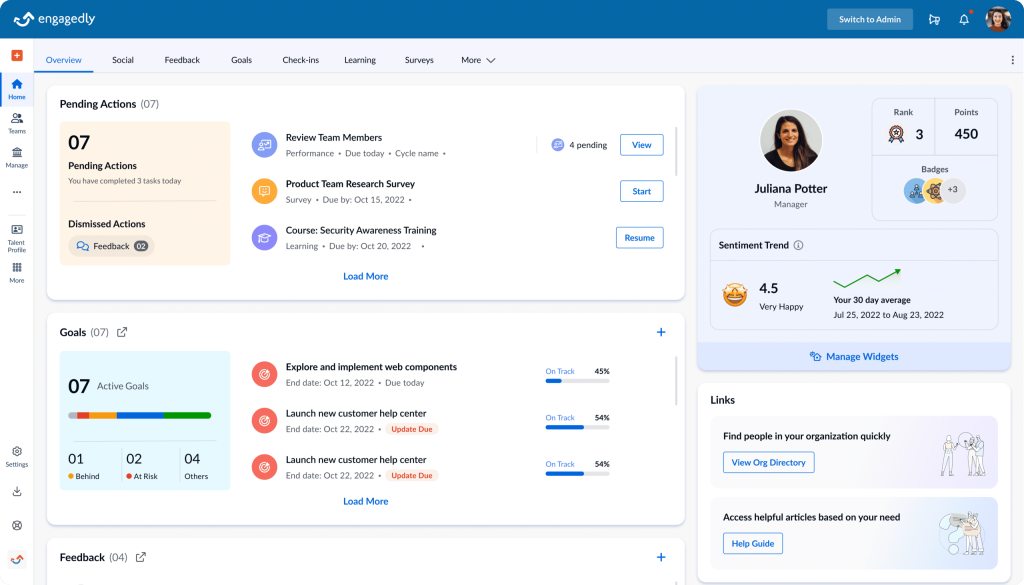
Image source: Engagedly
I tried Engagedly when we were interested in leveraging AI in our performance and engagement processes. I found the interface very modern and user-friendly, which meant our team had little trouble adopting it. Engagedly’s strength is in unifying multiple aspects of talent management: performance reviews, goals (including OKRs), engagement surveys, learning (they have an LMS module), and even gamified recognition all in one system.
Using Engagedly, we could align individual goals to company objectives and get nudges from the system (their AI assistant “Marissa”) about things like who might be ready for recognition or if a goal was at risk. The continuous feedback tools were effective – for example, Engagedly prompted us to give feedback frequently and had a feature to do anonymous feedback as well.
A fun element was the gamification: it has leaderboards and badges, so when someone completed training or got high feedback scores, it would celebrate that, which actually boosted motivation on our team. On the flip side, we did encounter a couple of minor hiccups: once, an update rollout caused some workflow confusion until we got used to the changes.
Pros:
- Engagedly was easy to navigate for both employees and admins. The clean design meant my team needed minimal training to use the platform daily.
- Continuous feedback and goal alignment are baked into the system – managers and employees can give real-time feedback.
- Gamification features (like badges, points, and leaderboards) add a fun element to engagement.
- Engagedly isn’t just performance management; it also includes employee engagement surveys, learning management, succession planning, and recognition in one platform.
Cons:
- Occasional platform updates had a tendency to temporarily disrupt our workflow or confuse users.
- Reporting, while solid, could be more robust. I found the standard reports useful, but when I tried to do very complex data analysis, I had to export to Excel.
How Engagedly Compares to 15Five:
When I used Engagedly, I appreciated how it merged performance management, engagement surveys, and learning into one unified experience—something that 15Five offers in parts but not always with the same depth. Engagedly’s AI-driven insights and gamification features helped boost participation and recognition across our teams. If you’re aiming for a platform that covers feedback, goals, and development in one place, Engagedly offers more versatility than 15Five.
Pricing:
Starts at $5–$8 per user/month (annual billing).
8. PerformYard – Best for Flexible Performance Review Cycles

Image source: PerformYard
PerformYard is designed for companies that want full control over their performance review cycles. It allows HR teams to build custom review forms, schedules, and workflows that fit annual, quarterly, or even project-based reviews.
Managers appreciate its simple layout that keeps reviews and feedback straightforward. Employees can provide input or update goals easily without navigating complex menus, ensuring higher participation.
Organizations like PerformYard for its focus on flexibility without bloat. It doesn’t try to do everything—just performance management extremely well, making it ideal for teams with unique processes or review timelines.
Pros:
- PerformYard lets you run performance reviews on whatever timeline you need – annual, quarterly, project-end, ad-hoc, you name it.
- Supports 360-degree feedback to gather input from peers, direct reports, and managers.
- Automated reminders and notifications made sure nobody missed a deadline for submitting reviews or feedback.
- The simple design earned compliments from our users – even less tech-savvy folks found it easy to complete their reviews.
Cons:
- PerformYard focuses strictly on performance management. It doesn’t offer extra modules like engagement surveys or learning.
- Customization of feedback forms had some limitations. While we could add questions and rating scales, we sometimes wished for more question types or conditional sections.
How PerformYard Compares to 15Five:
When I used PerformYard, I appreciated how it focused on the full performance-review cycle—from review forms and goal tracking to calibration and analytics—rather than just weekly check-ins. While 15Five excels at continuous feedback and engagement, PerformYard gives you greater customization of review workflows, flexible scheduling, and detailed performance reporting, making it ideal if your organization runs complex or non-standard performance cycles.
Pricing:
Starts at $5/user/month (billed annually).
9. HiBob – Best for HR & Basic Performance
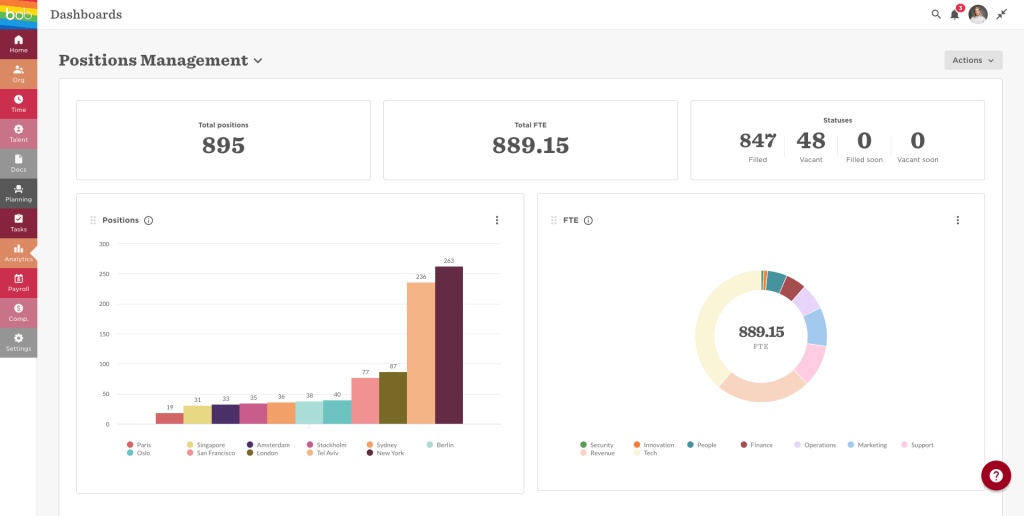
Image source: HiBob
HiBob (Bob) is another platform I’ve experienced, primarily as an HRIS that also covers performance basics. HiBob made HR administration easier (onboarding, time-off, record-keeping) while also giving us tools like performance review cycles, goals, and even a social feed for recognition. I found HiBob’s interface intuitive – for example, creating a performance review template or a survey in Bob was straightforward with drag-and-drop sections.
One of my favorite parts was the shoutouts and Kudos features – employees could publicly recognize each other, which built a positive vibe on our company feed. As an HRIS, HiBob maintained all employee data, so when performance review time came, it was all integrated (no importing users).
I will say, some of HiBob’s performance features felt more “lightweight.” It’s great for a basic annual review or goal setting, but it might not satisfy a company looking for intensive continuous performance tracking or complex analytics.
Pros:
- HiBob combines HR management (time off, org charts, payroll integration) with performance management and engagement, helping teams streamline people operations while keeping employees connected across the organization.
- Employee self-service is strong – people can update their own profiles, set personal goals, and even initiate feedback.
- Includes features like Shoutouts/Kudos for peer recognition and surveys/pulse checks to measure engagement.
- Bob looks and feels a bit like a social network for your company, which helped drive adoption.
Cons:
- Some performance features felt limited or too basic like the goal-setting module.
- Customization options are somewhat limited. It provides templates but it lacks variety.
How HiBob (“Bob”) Compares to 15Five:
While 15Five focuses on frequent check-ins, continuous feedback and performance reviews, HiBob offers a broader HRIS experience with performance management built in. I found Bob especially useful for managing core HR tasks like onboarding, time off, and benefits alongside reviews — making it ideal if you want a unified HR + performance platform rather than a pure feedback tool. However, if weekly check-ins and real-time continuous feedback are your primary focus, 15Five still leads in that specific niche.
Pricing:
Custom pricing.
10. Officevibe – Best for Employee Engagement Feedback & Insights

Image source: Workleap Officevibe
Officevibe focuses on engagement rather than formal reviews. It uses pulse surveys and anonymous feedback channels to capture real employee sentiment week after week.
Managers get actionable insights from dashboards showing trends in morale, relationships, and communication. Employees can send “Good Vibes” messages and anonymous comments that start meaningful conversations.
For teams prioritizing trust and openness, Officevibe creates a safe space for feedback. It’s not a full performance suite but pairs well with review platforms to give leaders a clear view of engagement health.
Pros:
- Officevibe’s pulse surveys provide a safe channel for employees to voice concerns or satisfaction.
- Allows team members to send each other positive feedback (“Good Vibes”), and we saw a lot of shoutouts being exchanged once we introduced it.
- The dashboards highlighted key engagement metrics and even provided suggestions for managers on how to improve scores in areas where their team was low.
- Officevibe’s pricing is reasonable for the value it provides (and it has a free version for very basic use).
Cons:
- Officevibe is not a full performance management tool. It doesn’t handle performance evaluations, compensation, or deep development tracking.
- Analytics are limited to engagement data. It won’t, for example, tie into your KPIs or turnover rates unless you manually correlate them.
How Officevibe compares to 15Five:
When I used Officevibe with my team, I found it ideal for gathering anonymous pulse surveys and engagement feedback, making it easy to spot morale and culture issues. While 15Five is more focused on performance reviews, OKRs and frequent check-ins, Officevibe leaned into engagement and transparency in a simpler way. For teams looking to build trust and open feedback loops first, Officevibe offered a lighter, more engagement-focused alternative to 15Five.
Pricing:
Starts at $5/user/month (annual billing).
11. Quantum Workplace – Best for Data-Driven Engagement & Performance Analytics
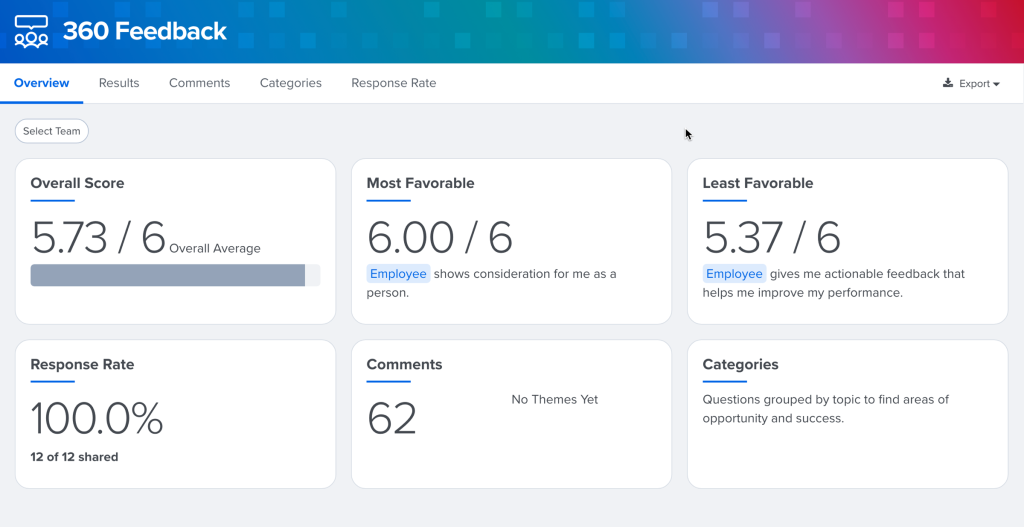
Image source: Quantum Workplace
Quantum Workplace combines engagement surveys, performance reviews, goals, and recognition within one robust analytics engine. It’s known for its research-based surveys used by many “Best Places to Work” programs.
Managers can use its visual dashboards to identify key engagement drivers and link them to performance outcomes. Built-in recognition tools encourage appreciation, while one-on-one and goal-tracking modules keep communication structured.
Companies that value insights love Quantum Workplace for its reporting depth. It’s ideal for medium to large organizations that want data to guide every aspect of employee growth.
Pros:
- It’s truly end-to-end – you can measure engagement, conduct performance reviews, set goals, facilitate one-on-ones, and launch recognition programs all within Quantum Workplace.
- The platform offers clear engagement scores across different dimensions and allows slicing by department or tenure.
- Very user-friendly for employees and managers once you get used to it. The tool keeps important items like goals always visible to users, which is helpful for focus.
- A built-in recognition feature to boost morale when people’s achievements were recognized on the platform.
Cons:
- The survey and feedback customization had a few limitations like formatting issues.
- Quantum Workplace typically operates on an annual contract with a minimum spend, so it’s really aimed at medium to large organizations.
How Quantum Workplace Compares to 15Five:
When I used Quantum Workplace, I noticed how it leans into data-driven performance and engagement workflows, offering tools like AI-assisted review drafting, automated reminders, and goal/feedback integration. While 15Five focuses on weekly check-ins and coaching moments, Quantum Workplace gives a broader framework for aligning goals, formal reviews, and continuous feedback across larger teams—making it better suited when you’re scaling performance management into a strategic program.
Pricing:
Custom pricing.
12. Reflektive – Best for Continuous Feedback & Recognition Focus
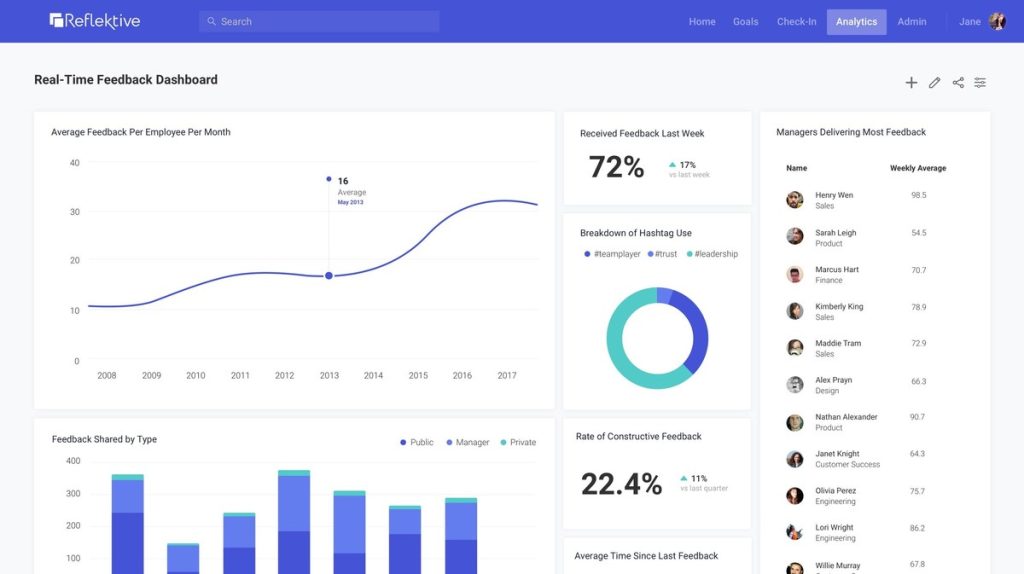
Image source: PR Newswire
Finally, let’s talk about Reflektive, which I experimented with as a continuous performance and feedback platform. Reflektive has been around for a while in the performance management space, focusing on real-time feedback, check-ins, and goals.
When I used Reflektive, I found that it really encouraged a culture of ongoing conversations. For instance, it integrates with Outlook and Gmail, so you can give feedback or recognition to someone directly from your email. This was a nice touch because it met people where they worked. We used Reflektive’s Goals module to set quarterly OKRs, and I liked how easy it was for employees to update their progress.
Reflektive also has a lightweight performance review capability, but it’s designed to make reviews feel less like a once-a-year ordeal and more like part of a continuous cycle. For example, you can pull in all the feedback and notes from throughout the year when writing a review, which gives a richer picture of performance.
Pros:
- Reflektive helps employees give and receive feedback anytime, not just during formal review periods.
- Includes a built-in recognition system that lets peers publicly appreciate each other’s contributions, boosting morale and visibility.
- The goal-setting interface is user-friendly. You can set goals, align them up or down with others, and update progress easily.
- Reflektive provides tools for managers to have structured one-on-one meetings – you could set an agenda, jot down notes, and track commitments.
Cons:
- While fully functional, Reflektive’s design felt a bit dated compared to some newer platforms.
- Integration for certain features (like if you wanted to tie into an HRIS beyond basic user provisioning) was not as extensive out-of-the-box.
How Reflektive Compares to 15Five:
When I used Reflektive, I appreciated how it emphasized continuous feedback and integrations that meet employees where they are—like giving feedback straight from email or Slack. While 15Five excels at engagement, check-ins and review cycles, Reflektive felt more focused on real-time feedback, goal updates and coaching prompts. For companies looking to transform one-off reviews into ongoing conversations, Reflektive provided a smarter, more agile option than 15Five.
Pricing:
Custom pricing.
Top 3 Picks for 15Five Alternatives
In my experience, selecting the right performance management tool involves evaluating key features such as customization options, integration capabilities, and user engagement. Based on these criteria, here are three standout platforms:
1. PeopleGoal
I found PeopleGoal to be a game-changer in customizing performance management workflows. The platform allowed me to build HR apps without any coding, enabling a personalized approach to performance reviews, goal tracking, and employee development.
2. Engagedly
Engagedly stood out to me with its AI-driven capabilities that unified performance management, employee engagement, and learning management into a single platform. The AI SuperAgent feature helped in overcoming challenges like inconsistent performance evaluations and low engagement.
3. Lattice
Lattice impressed me with its comprehensive HR suite that included OKR tracking, performance reviews, and real-time feedback. The platform’s goal-setting features, such as goal trees, allowed me to align individual objectives with company-wide goals effectively.
Evaluation Criteria
When I set out to find the best 15Five alternatives, I wanted tools that don’t just look good on paper but actually make performance management easier for real teams. Here’s how I evaluated them:
- Customization and Flexibility: I looked for platforms that let you shape performance reviews, feedback forms, and goal-tracking workflows the way your company works—not the other way around. Flexibility was key because no two teams manage performance the same way.
- User Experience and Interface: If a tool feels confusing or cluttered, no one will use it. So, I focused on software with clean, intuitive interfaces that employees and managers can pick up without a learning curve. The easier it is to navigate, the more likely people are to engage.
- Integration Capabilities: I prioritized tools that fit seamlessly into your existing tech stack. Whether your team works in Slack, Google Workspace, or an HRIS platform, integration makes performance management feel like a natural part of everyday work instead of an extra task.
- Feedback and Recognition Features: The best platforms encourage feedback to flow freely. I looked for tools that make it simple to share appreciation, give constructive feedback, and run quick check-ins—because performance management should build connection, not just track data.
- Goal Setting and Tracking (OKRs): Goal alignment was another big factor. I leaned toward tools that support structured frameworks like OKRs or SMART goals, so everyone—from individuals to teams—can stay aligned on what really matters.
- Scalability and Support: I also considered how well each tool grows with your company. Strong customer support and onboarding resources make a big difference when you’re scaling fast or introducing performance reviews for the first time.
- Pricing and Value for Money: Finally, I compared pricing to features. Some platforms justify a higher cost with robust functionality, while others deliver solid value at a lower price point. My goal was to highlight tools that give you the most impact for your budget.
Find the Right 15Five Alternative to Elevate Your Team’s Growth
Choosing the right performance management tool isn’t just about ticking feature boxes — it’s about finding a system that truly supports how your people work and grow. Whether your focus is on driving engagement, improving feedback loops, or aligning goals, the right platform should make these processes easier, not more complicated.
Every team has its own rhythm. Some thrive with data-rich analytics, while others prefer a simpler setup that encourages quick, meaningful feedback. The key is to look for something that adapts to your culture, integrates smoothly with your existing tools, and grows as your organization evolves.
If you’re exploring what’s next after 15Five, try starting with a flexible, customizable platform like PeopleGoal. It lets you design workflows, feedback processes, and goals that fit the way your team actually works — giving you more control over how you build a culture of growth and continuous improvement.
Frequently Asked Questions
How do I choose the right 15Five alternative?
Consider factors like customization capabilities, integration with existing tools, user experience, scalability, and pricing. Assessing these aspects will help you select a platform that aligns with your organization's specific needs and goals.
Do 15Five alternatives offer mobile-friendly or non-desk worker capabilities?
Yes, many next-gen alternatives emphasise mobile accessibility and non-desk worker usability. Features like mobile check-ins, push notifications, and integrations with communication tools (Slack, Teams) ensure that feedback and goals are accessible to every employee type.
Are there any free or very low-cost options among the 15Five alternatives?
Yes — some alternatives offer free or affordable entry-level plans, perfect for small teams or pilot programs. For example, PeopleGoal provides a free 7-day trial and flexible paid plans, making it easy to explore its customizable goal-setting and performance management features without a large upfront investment.
Ready to 3x Your Teams' Performance?
Use the best performance management software to align goals, track progress, and boost employee engagement.

